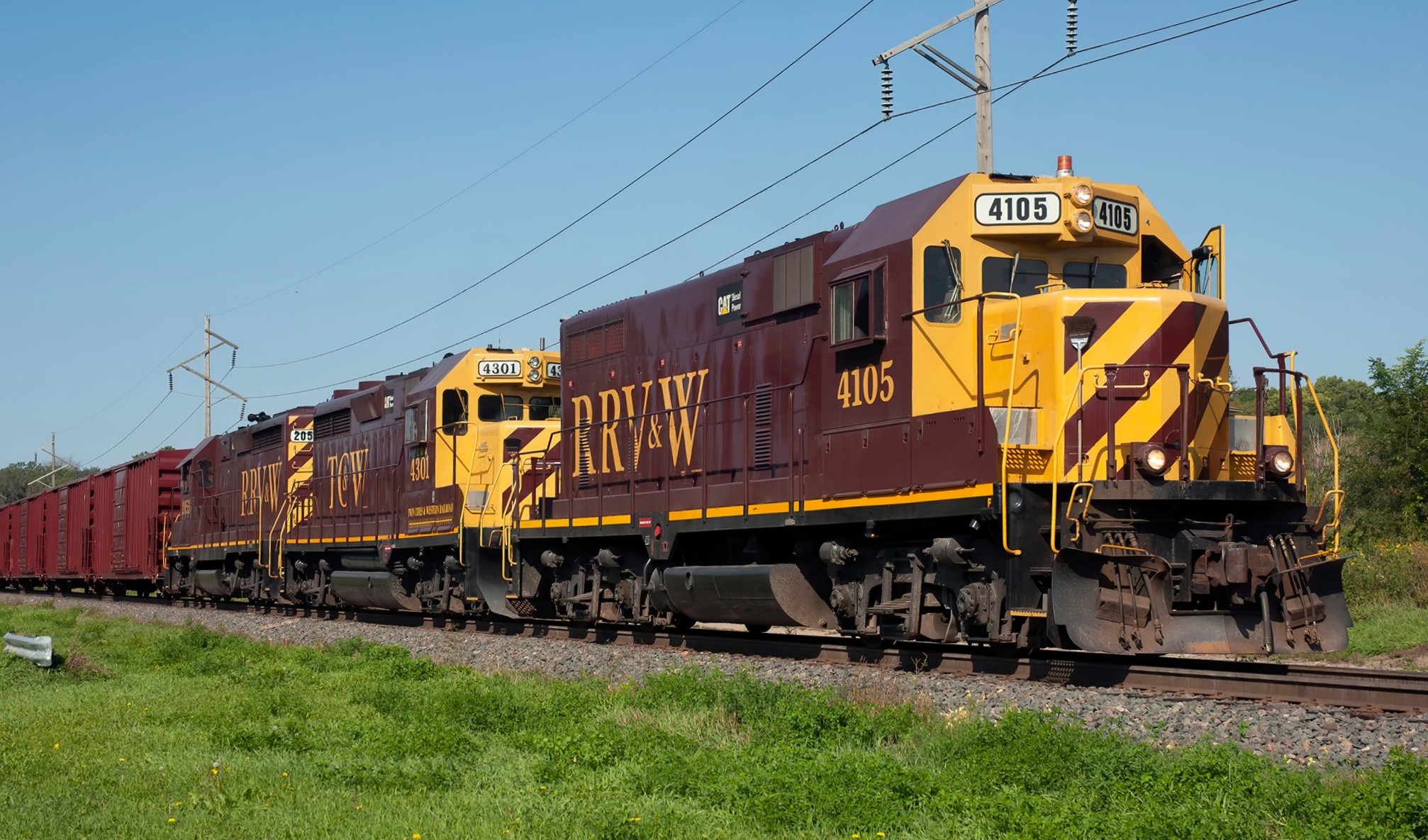Upgrade of an Existing Model |
Grand Trunk Western #1000
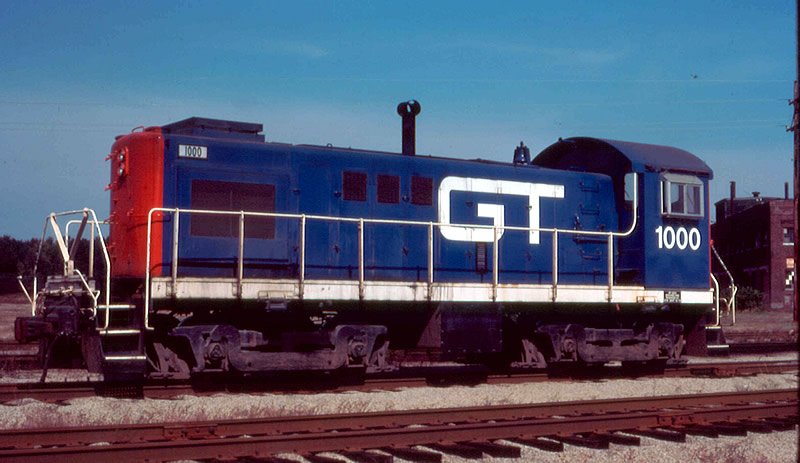
Alco S4 #8084 joined the GTW roster in 1955. Twenty-four years later, it was one of four Alco
switchers rebuilt with a Caterpillar 12-D398 engine by the railroad. The newly re-powered
#1000 was dubbed a CS9 and worked 15 more years prior to being sold. The unit's next stop
was the COE Rail operation located in Wixom, Michigan. (John C. Benson photo at Battle Creek,
MI on 28 September 1980) |
Norfolk Southern #103
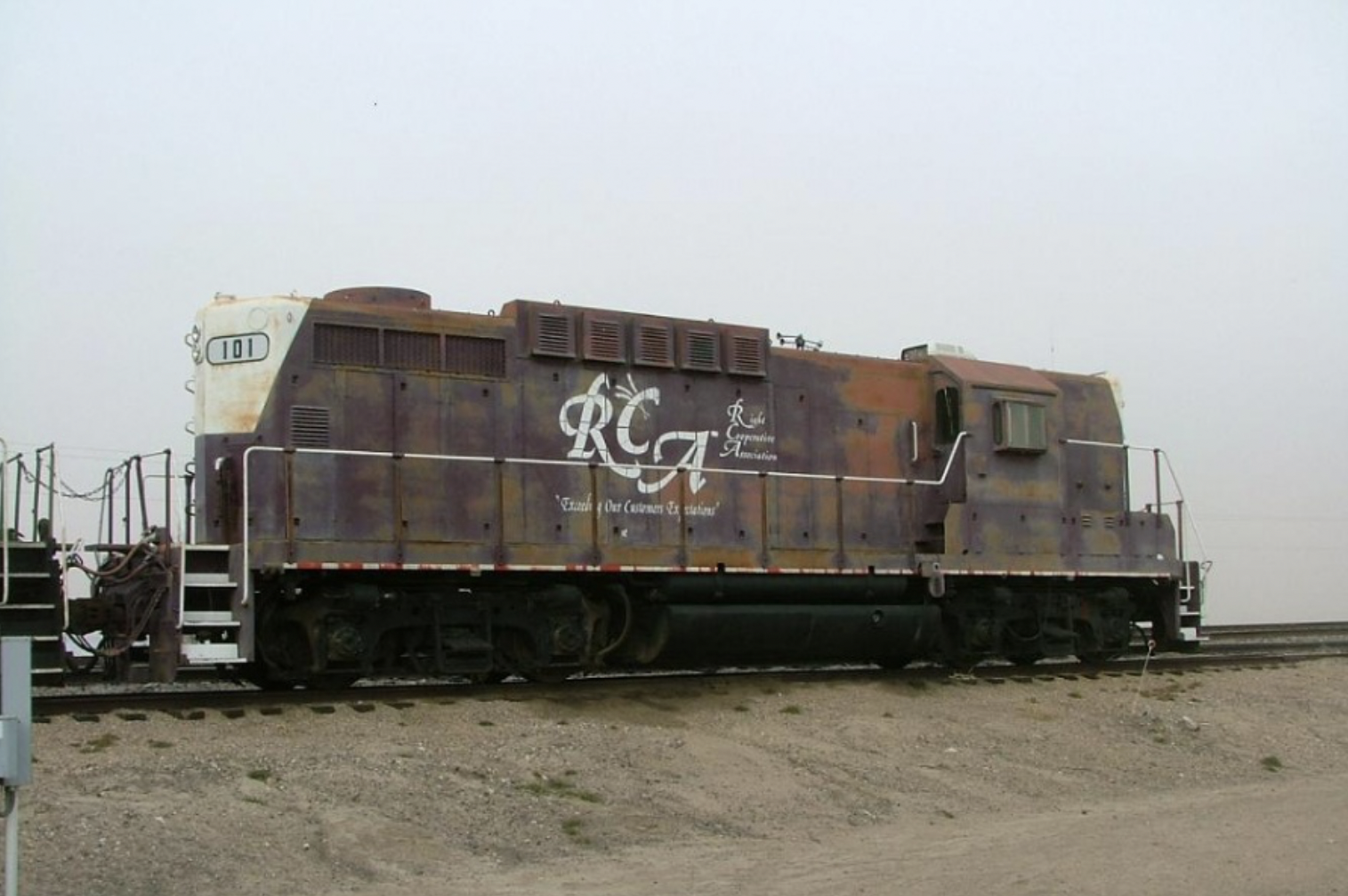
The Roanoke, Virginia Shops of NS converted five EMD GP9s into TC10 transfer locomotives
between 1984 and 1986; they were #101-105. The transformation project included installation
of a non-turbocharged Caterpillar 3512 power-plant rated at 1050 horsepower and fabrication
of a hump to house added ventilation and exhaust. (Ben Heisel photo) |
Chicago & North Western #6000
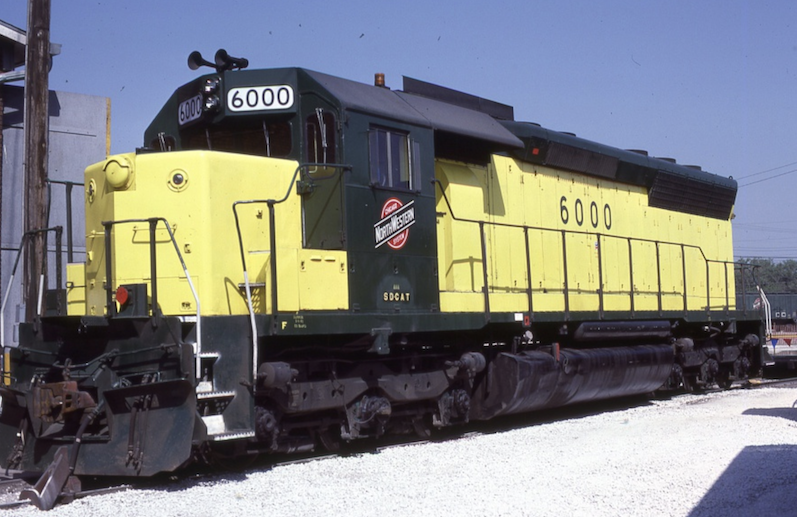
In the latter months of 1985, C&NW replaced the 20-cylinder 645 engine in SD45 #6547 with a
Caterpillar 3612 engine connected to an AR10 main generator; the results were marginal as
SD45u #6000 was sidelined prior to 1990. The one-of-a-kind loco was sold to Helm, which rebuilt
it into a SD45M-3. (Tom Wilson photo / Ralph Back collection) |
Santa Fe #5855
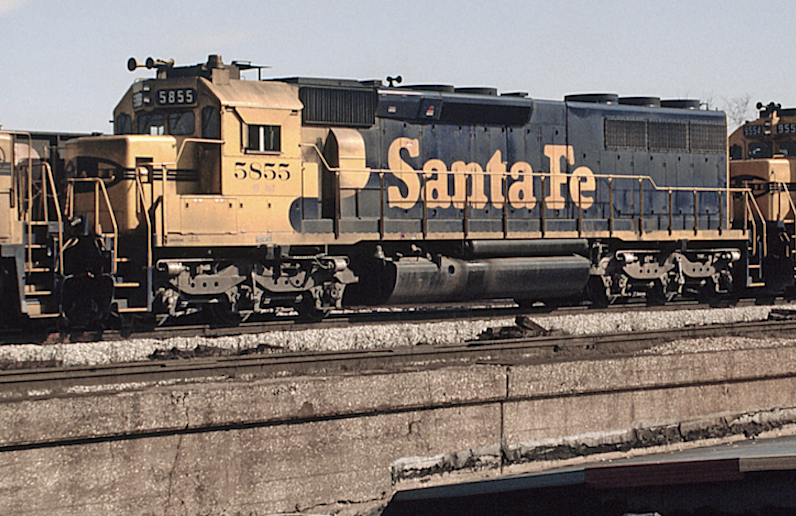
Santa Fe #5855 was re-engined with a 4250-hp Caterpillar 3612 engine in July 1987; the loco
had been built in May 1972 as #5625, the railroad's first SD45-2. It was retired five years
later and sold to Morrison-Knudsen. The final owner was Utah Railway #9012. (Tom Golden photo
at Joliet, IL in May 1988 / Marty Bernard collection) |
Burlington Northern #6330
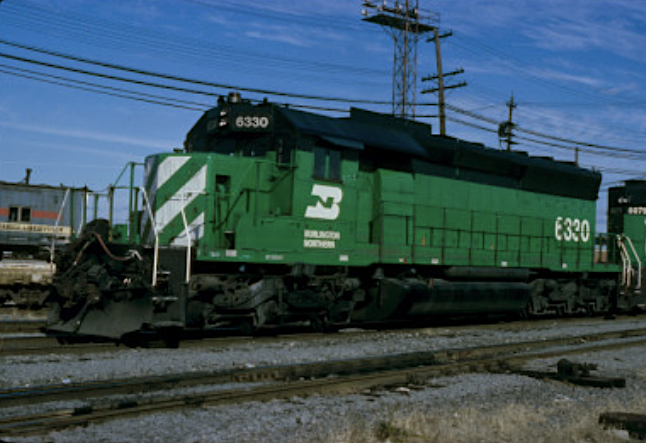
The work to re-power this SD40-2 with the CAT prime mover was done by the BN shops at Galesburg,
Ill. The replacement engine was also a 3612. Prior to the ATSF/BN merger the six-axle EMD
was retired and sold to sold Helm, which in turn rebuilt it as an Indiana Harbor Belt SD38-2.
(John C. Benson photo 1988) |
Canadian Pacific #4711
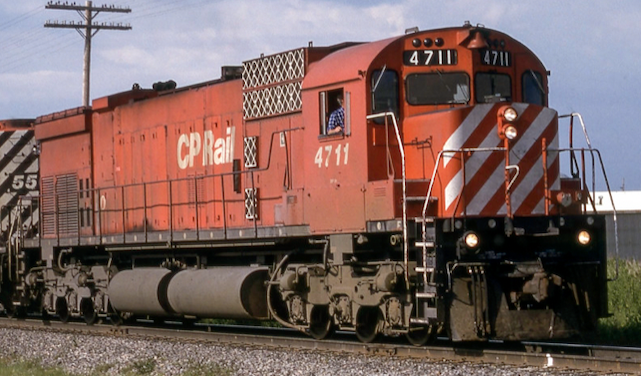
Perhaps the most unusual of the many Caterpillar projects highlighted in this photo essay
is CPR's MLW-designed ex-M636 #4711 from 1988. The replacement engine was a Caterpillar 3608
(the largest engine block in the CAT catalogue) installed by Peaker Services in Michigan.
Re-classified as a M630CAT, it was sold to Minnesota Commercial (#71). (Mike Hoff photo /
Chuck Schwesinger collection at Gladstome, MI on 25 June 1992) |
Burlington Northern #2000
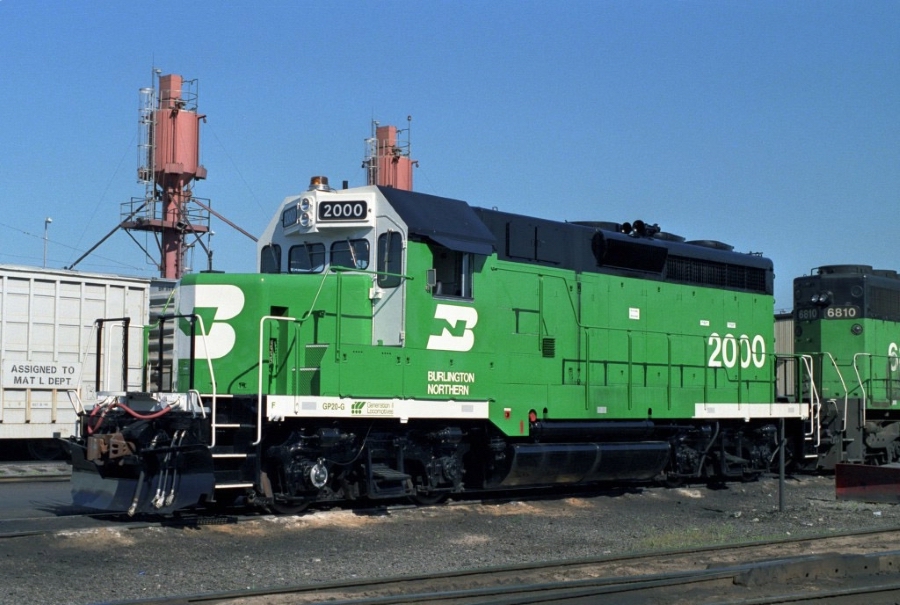
BN's engine replacement program got underway during 1988, with the first of ten GP20Cs #2000
completed in September. Ex-CB&Q #2059 served as the prototype and received a Caterpillar 3516
2075-hp engine mated to a Kato alternator. Four additional rebuilds followed in 1989, with the
last replacements finished during the first quarter of 1990. The rebuilds were
removed from the roster after only three years.( Ralph Back photo at Northtown Yard in Minneapolis
on 5 July 1989) |
Generation II #3516
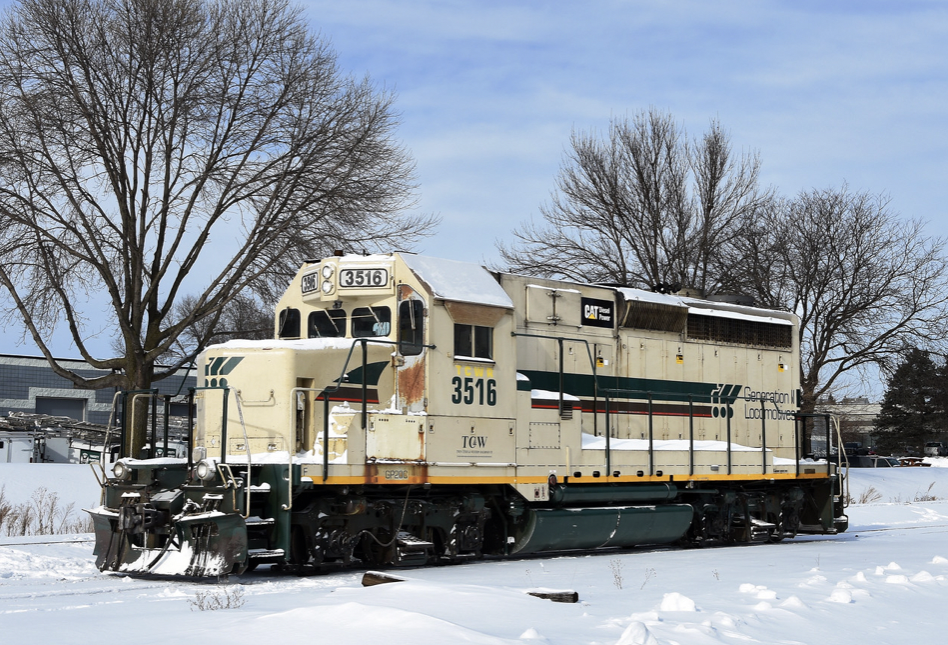
GP20C #3516 above was not the first Generation II Locomotive rebuild to wear a custom-painted
demonstrator paint scheme; the distinction belonged to CZK 2000 (Caterpillar-Ziegler-Kato ?).
Ziegler was a Minnesota Caterpillar dealer that performed the installation work offsite. In
1996, ex-BN GP20C #2008 was pulled out of storage and re-branded as the #3516 to reflect the type
of engine. (Robert Ball photo at Bloomington, Minnesota on 21 January 2020) |
Soo Line #4301
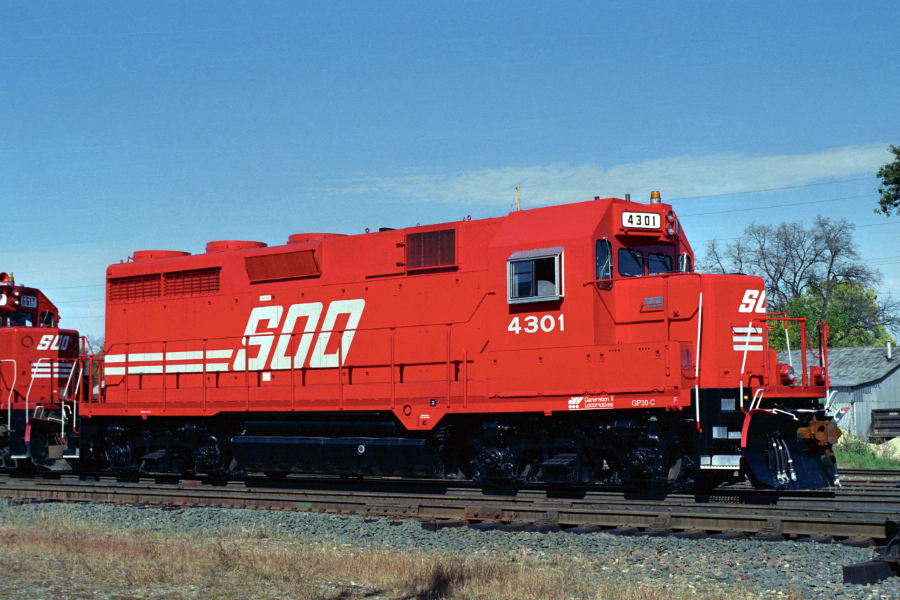
Generation II Locomotive Company in the fall of 1990 acquired three ex-Union Pacific GP30s.
The locomotive trio were subsequently rebuilt as GP30Cs with a Caterpillar 3516 2000-hp
engine that drove a 1250-volt Kato alternator. Ex-UP rebuilds #832, 828 and 805 surfaced
several months later sporting SOO line's bright red attire and carrying road numbers 4300-4302.
They were later sold to the Twin Cities & Western. (Ralph Back photo at Winona, Minnesota on
6 October 1990) |
Soo Line #4104
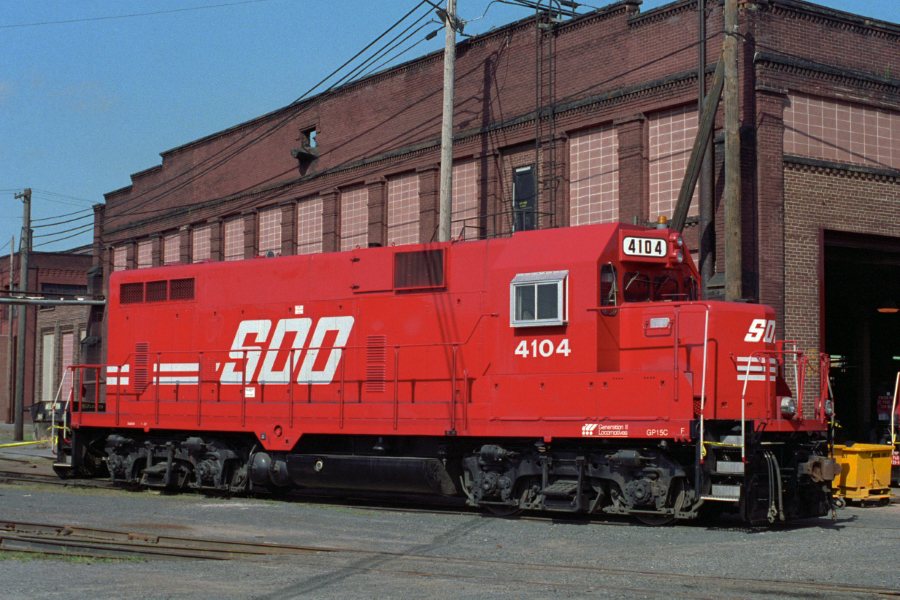
Generation II Locomotive Co. using ex-Conrail GP9s also built a seven-unit order of GP15Cs
#4100-4106 for the SOO Line. The rebuilds received a Caterpillar 3512 engine with a horsepower
output of xxxx. As had been the earlier practice, the engine was hooked to a Kato alternator
provided by Reliance Electric of Man(Kato) Minnesota. The core units were CR 7039, 7017, 7037,
7444, 7381, 7431, and 7312. (Ralph Back photo at Shoreham Yard, (Minneapolis) on 21 August 1993) |
Red River Valley & Western #2053
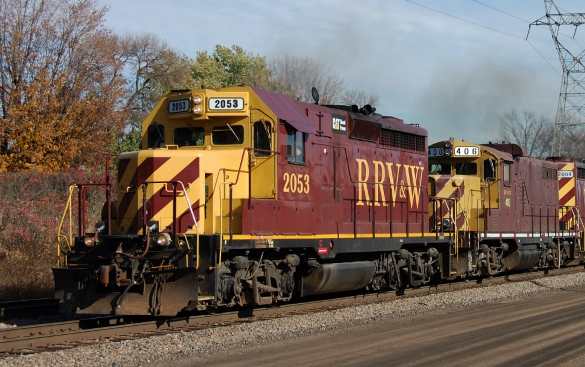
RRVW #2053 was one of three GP20Cs transferred from TC&W. Beyond the loco's BN #2003 lineage,
the four-axle road unit was originally Great Northern GP20 #2008. (Ralph Back photo at St. Paul,
Minnesota on 20 October 2007) |
Twin Ciities & Western #4300
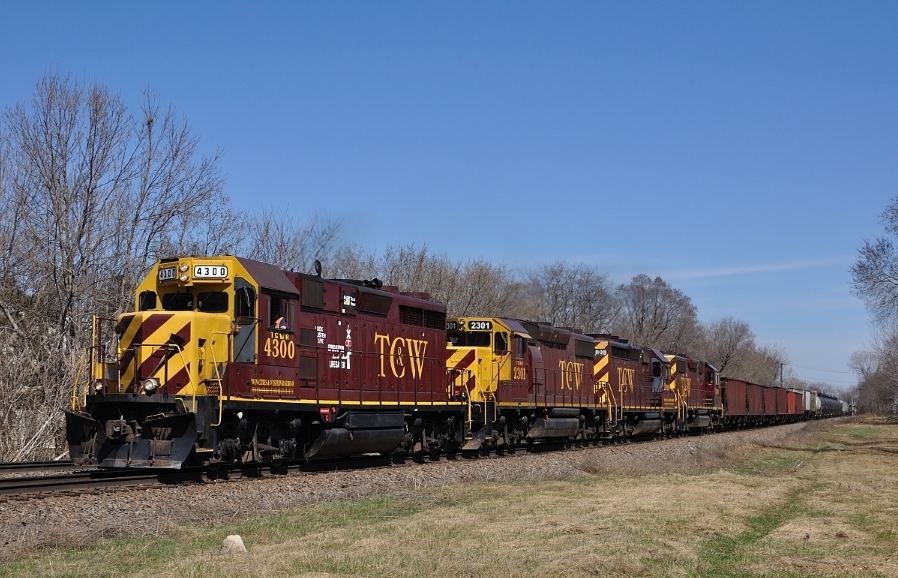
After a short stint on the SOO Line, GP30C #4300 (ex-Union Pacific GP30 #832) went to work
on the Twin Cities & Western in all types of road, transfer and yard service. (Ralph Back
photo at St. Paul, Minnesota on 12 April 2011) |
Peoria Locomotive Works #1500
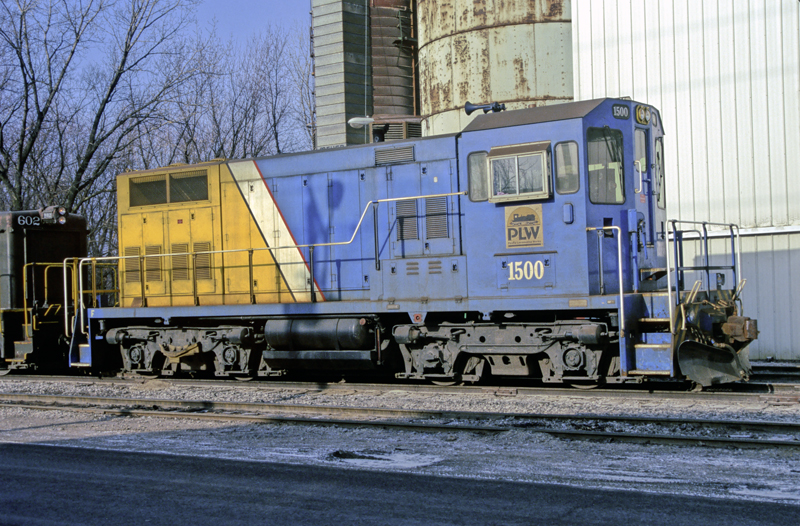
Demonstrator PL1500 was the first in a planned line of CAT 3512-driven switchers to be
produced by Peoria Locomotive Works. The unusal appearing end-cab afforded excellent vsibiity
and was one of the few rebuilds to ride on EMD flexicoil trucks. (Bon French photo at Pekin,
IL on 4 February 1997) |
Peoria & Pekin Union #802
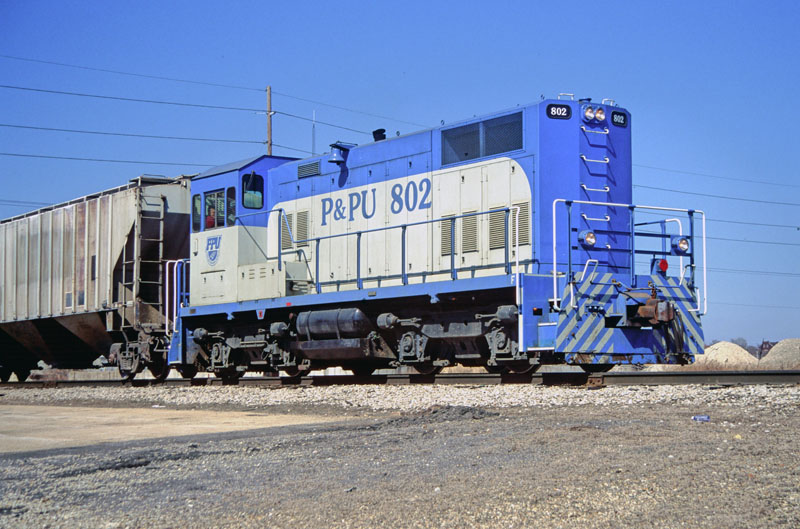
Peoria Locomotive Works demonstrator PL1500 generated nearly zero sales interest and
consequently the 1500-hp end-cab was transferred to parent company Peoria & Pekin Union as
their #802. (Bon French photo at Peoria, IL on 7 June 1998) |
Peoria Locomotive Works 2001
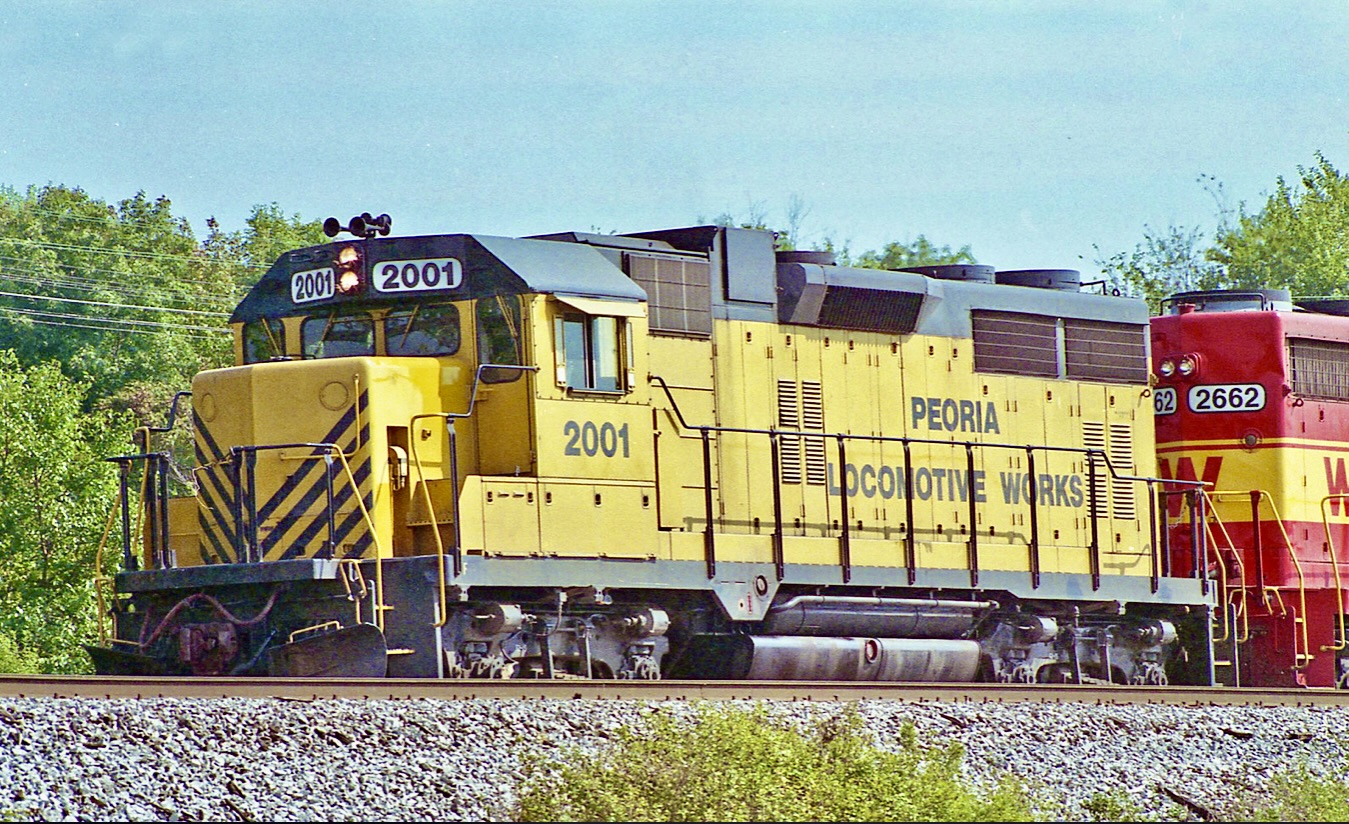
The paper air filter box on PLW #2001 readily suggests that the locomotive is not simply
a stock GP35. Built by VMV as demonstrator GP35C #3516, the four-motor locomotive's path
to the PLW started in 1964 as L&N #1111, with stops at SBD and CSX. (Craig Sanders photo
at Canton, Ohio on 16 September 1995) |
Republic Locomotive #2000
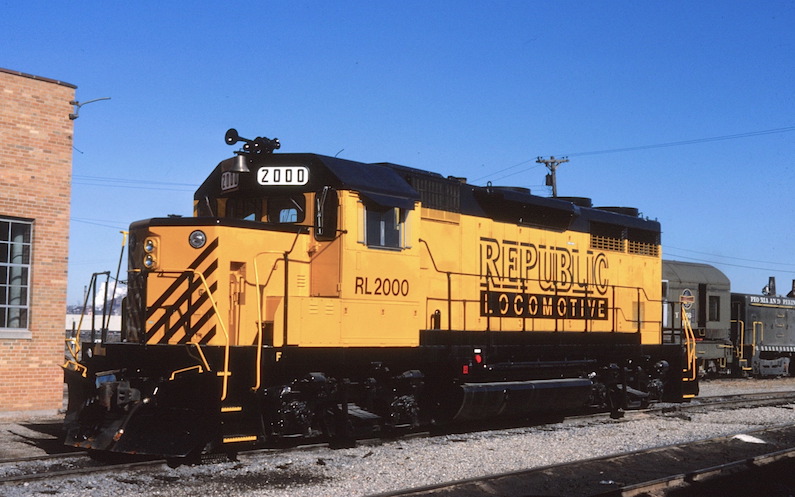
A bill board-size name on the flanks of GP35C #RL2000 Demonstrator clearly identifies the
1990 builder of this four-axle, CAT 3516-driven road-switcher. A lack of buyer interest
landed the loco on the roster of Peoria Locomotive Works in 1993. (James DuBose photo at
Creve Coeur, IL on 22 October 1988) |
Peoria & Pekin Union #2000 & 2001
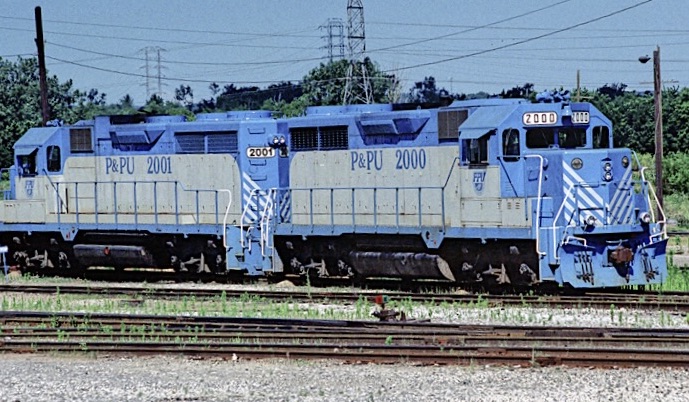
In-spite of modest external differences, P&PU's ex-Republic and VMV demonstrators are quite
similar internally given their Caterpillar 3516 power-plant, Kato alternator and micro-processor
control systems. (Bon French photo at Creve Coeur, IL on 1 July 1998) |
British Columbia Rail #609
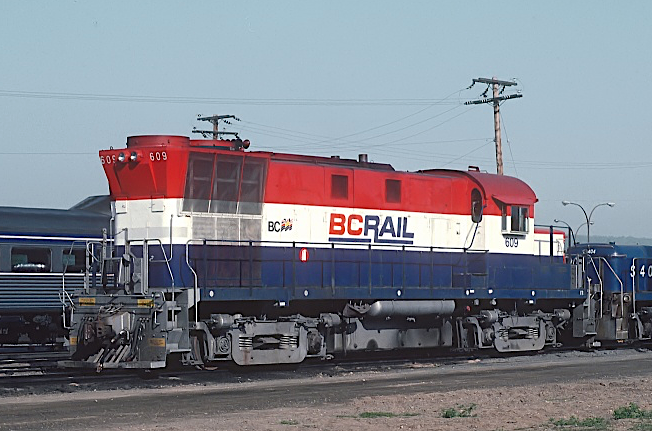
The largest collection of Caterpillar-powered locomotives belonged to BC Rail which operated
a fleet of 27 RS18Cs. Driven by 2000-hp Caterpillar 3512 engines, the Montreal Locomotive
Works-built became RS18Cs were upgraded at age 25. (Marty Bernard photo at Prince George, BC
on 23 May 1992) |
Heber Valley #4028

Heavy fog and snow provide a dramatic background for this portrait of a Heber Valley #4028.
Dubbed the "Big Boy" by HV crews, the ex-military road-switcher sports a 1000-horsepower
Caterpillar replacement engine. (James Belmont photo at Charleston, Utah on 31 January 2009) |
Northwest Railway Museum RS4-TC
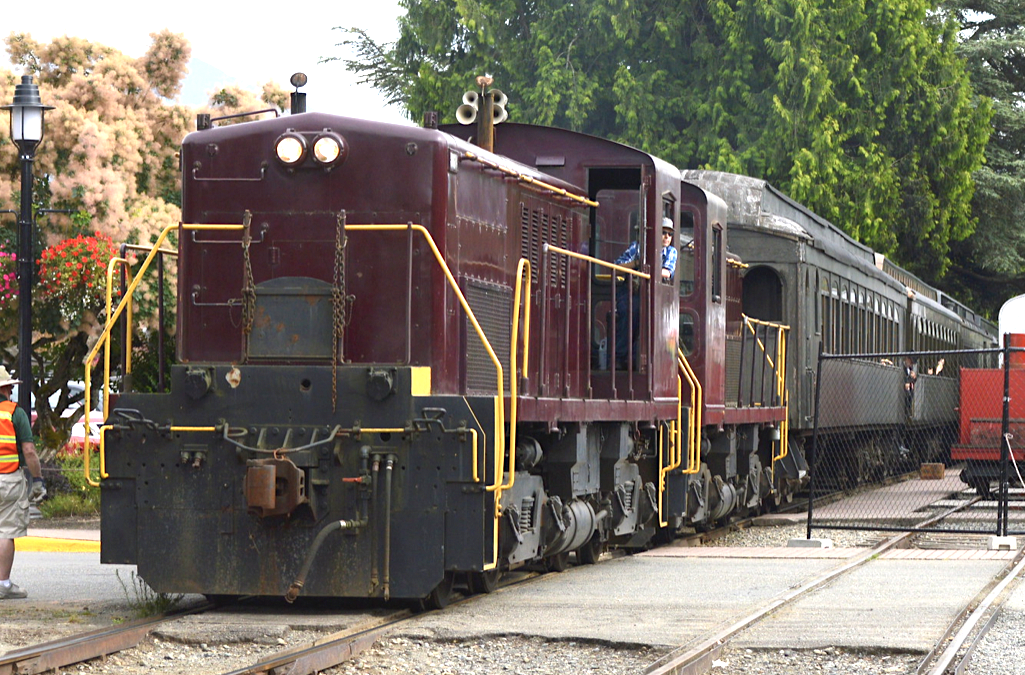
A pair of ex-U.S, Army RS4-TC's lead a daily summertime excursion at the Northwest Railway
Museum in western Washington. The two military veterans are driven by a Caterpillar 3508
V8-industrial engine. (Robby Gragg photo at Snoqualmie, WA on 16 July 2016) |
Texas State Railway #7
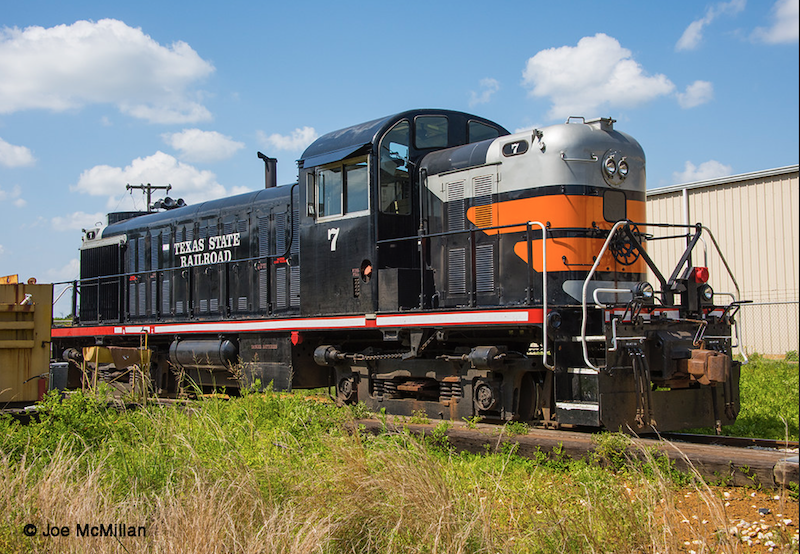
Brookville Locomotive Works installed a 12-cylinder CAT engine in Texas State Railroad's
#7 in 2003. The carbody of the Alco-built RS2 was also restored and painted in the popular
"black widow" scheme of Southern Pacific. When completed, the RS2CAT primarily worked excursion
traffic along the railroad's historic Rusk-Palestine line. (Joe McMillan photo at Palestine,
Texas on 25 June 2015) |
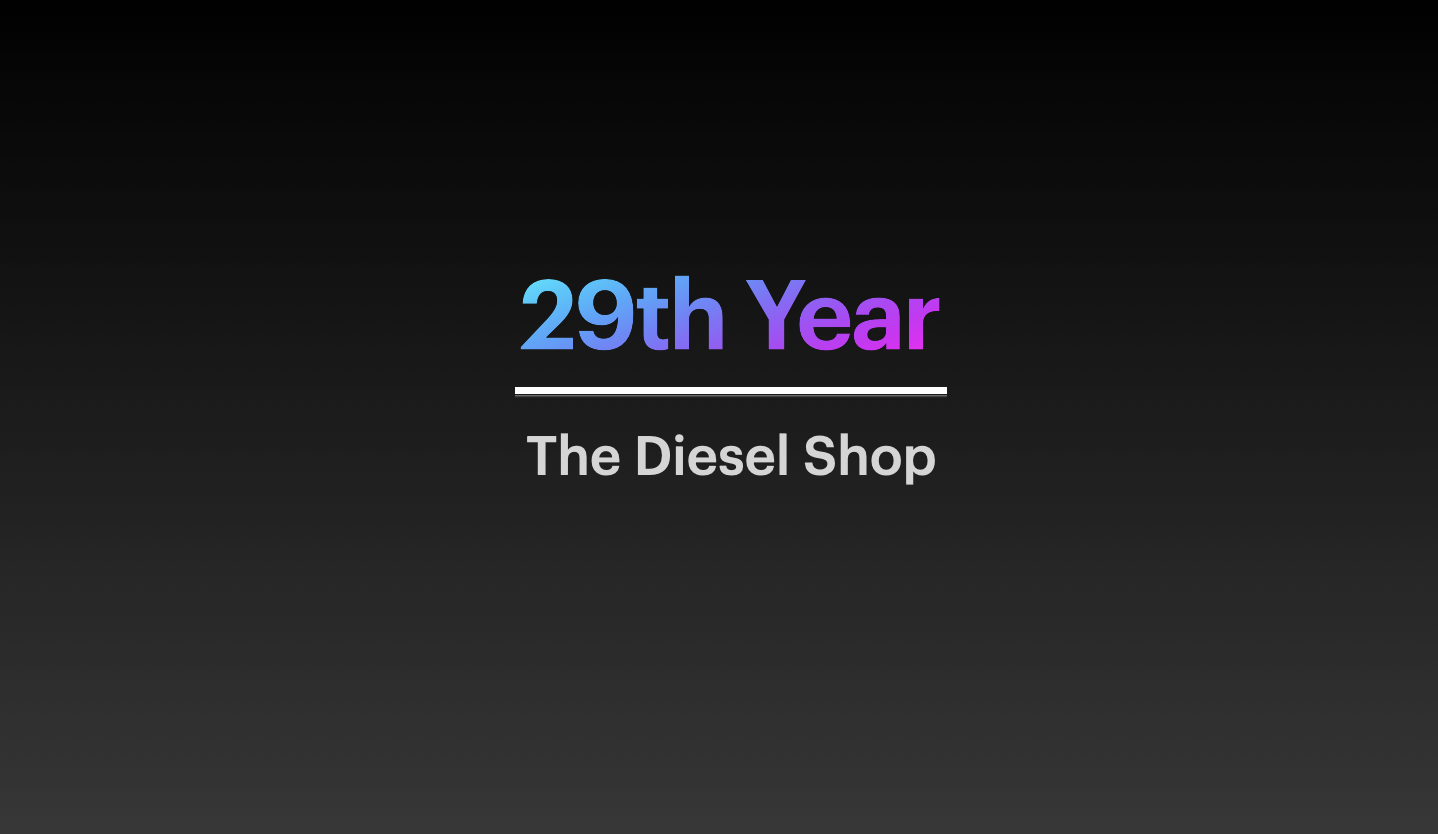
|
Construction of New Model
|
Southern Pacific #503
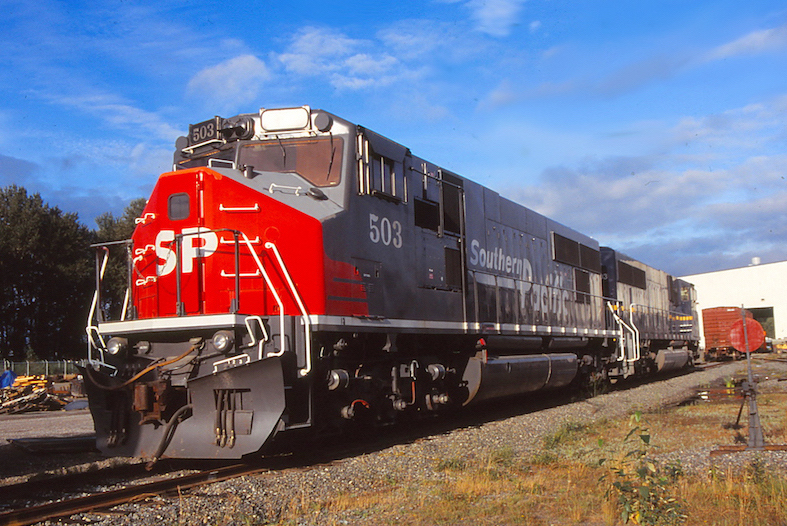
Espee's MK5000C #503 of 1994 was powered by the 5000-hp Caterpillar V12-3612 diesel engine,
which had a 11.0 x 11.8 in. bore & stroke with a 1,121 cu in. displacement per cylinder.
The 3612 engine had dual turbochargers and was mated to a Kato alternator. The #503 and
two sister units (501 and 502) were initially leased to Southern Pacific; returned after
two years, they stood idle until 2000. The trio were sold to the Utah Railway which later
had them rebuilt as SD50-3s. (R. Craig photo at Tacoma, WA on 19 September 1998) |
Progress Rail #1320
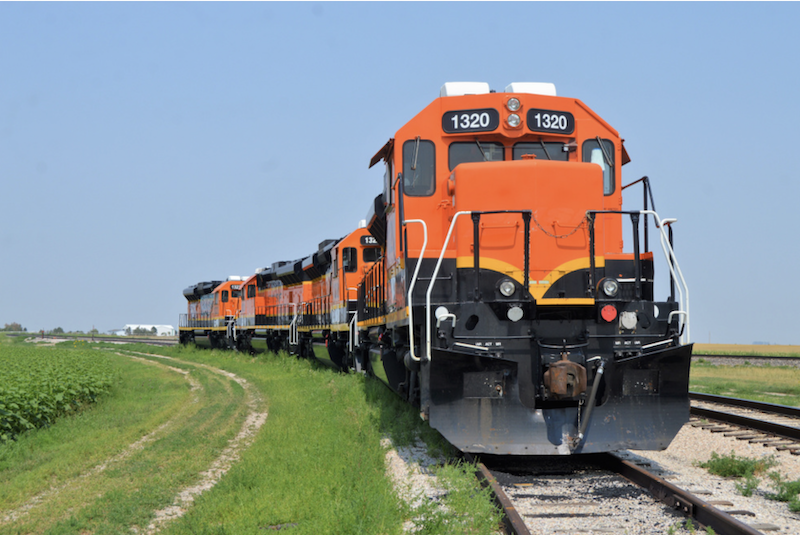
Still adorned in BNSF standard attire, un-lettered PR30C #1320, along with three sister units,
remains stored near Sidney, Nebraska for some yet undetermined amount of time. The Progress
Rail-built SD40-2 look-a-like houses a Caterpillar 3516 prime mover with an exhaust after
treatment system that cleans emissions from internal combustion engines. The PR30C quartet
field-tested on the Union Pacific prior to being purchased by BNSF. (Ben Heisel photo at
Sidney, NE on 5 August 2021) |
-- |
|
|
